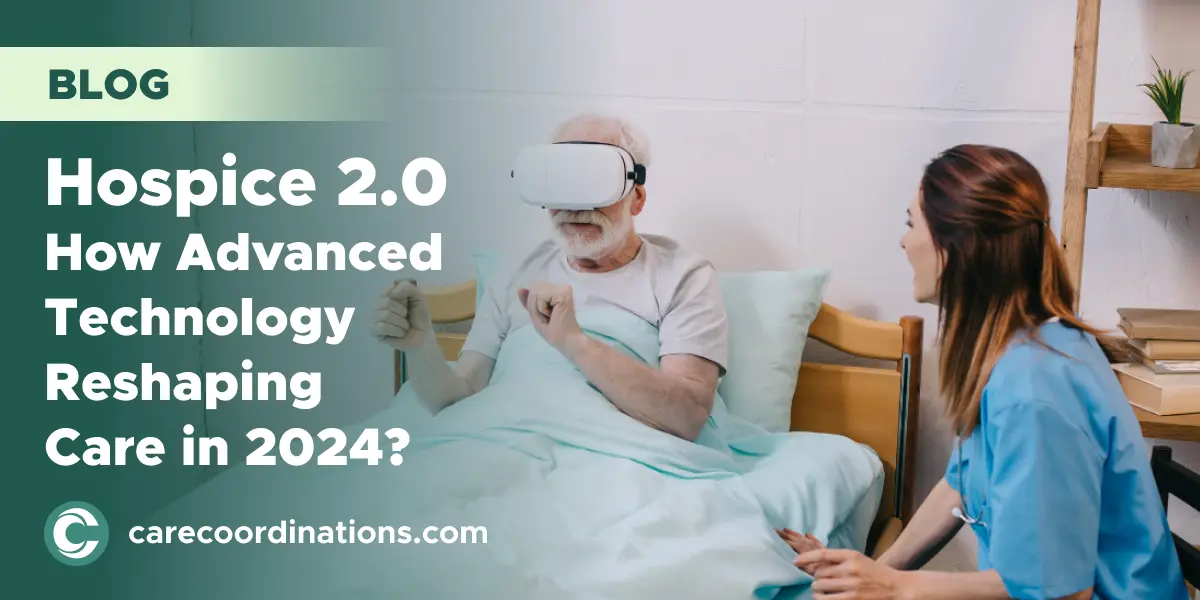Imagine a future where sterile walls and hushed goodbyes don’t define end-of-life care. Still, VR beaches wash away the pain, AI whispers guide personalized comfort, and wearables silently ensure peace of mind, all integrated seamlessly through innovative Hospice Software Solutions.
All this isn't science fiction; it's Hospice 2.0, a revolution driven by the latest technology and sophisticated Hospice Software Solutions, promising dignity, hope, and joy in the final chapter. Statistics say it all: 50% of Americans die without hospice care, missing out on a holistic approach that prioritizes comfort, pain management, and emotional well-being. But what if technology, including advanced hospice software solutions, could bridge this gap, offering comfort beyond physical touch and care personalized to every breath?
Join us as we explore the cutting-edge tools reshaping hospice, from AI-powered symptom management to VR escapes, wearables whispering reassurances, and apps connecting families across miles, all seamlessly integrated through Hospice Software Solutions.
Hospice 2.0 isn't just about gadgets; it's about redefining what it means to care, with technology and sophisticated Hospice Software Solutions as a gentle hand guiding the way. So, step into the future of care with us, where the human touch finds new expression through the magic of technology and advanced Hospice Software Solutions.
The Transformation of Hospice Care:
The evolution of hospice care in the United States is a testament to our commitment to compassionate end-of-life support. Initially rooted in volunteer-driven efforts, hospice care gained formal recognition in the 1970s.
However, technology is now ushering in a new era of hospice care. Telemedicine connects patients with healthcare providers, enabling remote consultations and monitoring. Electronic health records streamline information sharing, enhancing coordination among caregivers.
Moreover, wearable devices can track vital signs, ensuring timely interventions. These technological advancements not only make hospice care more accessible but also improve the quality of life for patients, offering comfort and dignity in their final journey.
Emerging Technologies in Hospice Care:
The landscape of hospice care in the United States is experiencing a technological revolution, bringing cutting-edge innovations to the forefront.
These emerging technologies are reshaping hospice care from advanced telemedicine solutions connecting patients with healthcare providers to implementing electronic health records for seamless coordination among caregivers and integrating wearable devices tracking vital signs in real time.
This technological wave isn't just about gadgets; it's about enhancing patient comfort and elevating care quality. It ensures that individuals facing end-of-life receive the utmost attention and support they deserve, all while empowering healthcare professionals to provide timely interventions and compassionate care.
In an era where every moment counts, these innovations significantly impact the lives of patients and their families.
Also Read: Overcoming Obstacles: Improving Accessibility for Home Health Care Recipients
Telehealth and Remote Monitoring:
The healthcare landscape is transforming with the rapid expansion of Telehealth and Remote Monitoring, particularly in hospice settings. This advanced technology is not only providing improved access to care but is also revolutionizing patient monitoring.
Through real-life case studies, we witness the profound impact of Telehealth, offering a glimpse into its success stories in hospice care. From virtual consultations to remote health tracking, integrating technology fosters a more compassionate and efficient approach to end-of-life care, ensuring that patients receive the support they need, wherever they may be.
Artificial Intelligence and Personalized Care:
Artificial intelligence (AI) has become a cornerstone in reshaping healthcare and exceptionally personalized care. AI revolutionizes symptom management by analyzing vast datasets to identify patterns, allowing for early detection and tailored interventions.
Predictive analytics are pivotal, offering healthcare providers valuable insights to optimize patient outcomes. However, ethical considerations and patient privacy are paramount. Striking a balance between harnessing AI's potential and safeguarding sensitive information is crucial.
As technology advances, the healthcare industry must uphold ethical standards, ensuring that AI-driven personalized care remains a beacon of innovation while respecting the privacy and autonomy of each patient.
Virtual Reality and Patient Comfort:
Virtual Reality (VR) transforms hospice care by offering a unique pain management and emotional support avenue. Patients, often dealing with physical discomfort and emotional distress, find solace in VR experiences that transport them to serene landscapes or nostalgic places, providing a respite from pain and anxiety.
Case studies abound with heartwarming success stories – terminally ill individuals finding peace as they virtually revisit cherished memories or pain diminishing during VR-guided relaxation sessions.
VR is more than technology; it's a powerful tool enriching the final moments of patients, highlighting the remarkable synergy between advanced tech and compassionate care in the American hospice landscape.
Also Read: From Home Care to Hospice: How Coordination Platforms Are Shaping the Future
Integration of Wearable Technology:
The healthcare landscape is witnessing a transformative integration of wearable technology. Wearables play a pivotal role in shaping patient autonomy and reassuring families, from monitoring vital signs to enabling proactive care.
These innovative devices empower individuals by offering real-time health data, fostering a sense of control over their well-being. Simultaneously, families find solace in the continuous monitoring capabilities, enhancing the overall quality of care and instilling confidence in the advanced healthcare ecosystem.
Hospice Care Apps:
The evolution of hospice care is exemplified through innovative mobile applications. Hospice Care Apps provide robust patient support and facilitate seamless family communication.
These apps boast features to enhance the overall hospice care experience, including real-time health monitoring, medication tracking, and secure family forums. These applications utilize cutting-edge technology and are pivotal in reshaping and enhancing our approach to end-of-life care.
Training Healthcare Professionals:
The ever-evolving healthcare landscape necessitates a simultaneous evolution in the skill sets of its professionals. Training programs have emerged to enhance the capabilities of hospice care staff, recognizing the crucial role of technology in the ever-evolving healthcare landscape. These initiatives address the urgent requirement for proficiency in state-of-the-art tools and techniques, ensuring that healthcare professionals are thoroughly prepared to navigate the complexities of advanced technology.
In this ever-evolving sector, continuous education becomes pivotal for delivering optimal patient care and embracing the transformative impact of the latest innovations.
Challenges and Considerations:
In the evolving realm of hospice care, we confront the dual challenge of ensuring equitable access to technology while preserving the irreplaceable human connection.
Bridging the digital divide is crucial, as not all patients can access high-tech solutions equally. Moreover, there's a delicate balance to strike between cutting-edge care and the invaluable human touch that defines hospice settings.
Technology should enhance, not replace, the compassionate care healthcare professionals and loved ones provide. Navigating these challenges calls for a holistic approach that harnesses technology's potential while honoring the enduring importance of human presence in the hospice journey for all Americans.
The Future of Hospice Care:
The future of hospice care in the United States is undoubtedly intertwined with technology. We foresee a continued surge in innovations like AI-powered symptom monitoring, virtual reality for emotional support, and telehealth for remote consultations.
However, policy and funding will be pivotal in shaping this evolution. Policies that promote equitable access to cutting-edge tech and funding initiatives supporting research and development are vital.
With the right policies and investments, technology can ensure that hospice care remains advanced and accessible, providing comfort and dignity to all Americans in their final journey. The future holds immense promise for hospice care, blending humanity with innovation.
Also Read: Future of Hospice Care Solution: AI and Machine Learning Integration
Be a Part of the Change: How We Can Contribute to Hospice Innovation
In conclusion, we've explored the remarkable impact of technology on hospice care, from VR's soothing embrace to telemedicine's accessibility. To be part of this change, let's advocate for policies supporting tech integration and fund hospice care solutions. Embracing innovation, we can ensure that every individual facing the end of life receives the best care, harmonizing the human touch with high-tech solutions and promising a future of comfort and compassion for all in hospice care.


